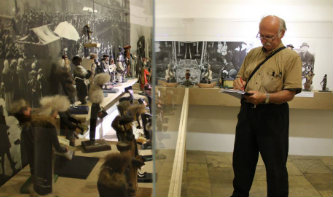Concordians abroad: Souvenir, Talisman, Toy in Krakow, Poland

When Erica Lehrer checked into her hotel in Krakow last month, she found her luggage guarded behind the reception desk by a life-sized statue of a bearded man with side curls, playing a double bass. It was further evidence, if she needed it, of Poland’s fascination with Jews, and its manifestation in the form of Jewish figurines.
The Concordia professor was in town to curate Souvenir, Talisman, Toy, at the city’s 23rd annual Jewish Culture Festival. The exhibition, which took place from June 30 to July 14, explored the popularity and meaning of the figurines. They are a point of major contention between local, non-Jewish Poles and Jewish visitors: foreigners are often offended by what they see as anti-Semitic representations of Jews, who in recent years have frequently been depicted holding coins or counting money.
Alternately functioning as souvenirs, toys, good luck charms and objects of deep nostalgia for pre-war Poland (even for Jewish buyers), the figurines come in all shapes and sizes, but almost always use stereotypical imagery based on centuries-old myths about Jews. They are sold everywhere from gas stations to art galleries.
Souvenir, Talisman, Toy inspired strong reactions, both from attendees and the Polish and foreign press. Here are Lehrer’s recollections and those of student volunteer Lauren Ramsay, who travelled to Poland from Montreal to work on the exhibition.
Erica Lehrer
Curator of Souvenir, Talisman, Toy
Canada Research Chair in Post-Conflict Memory, Ethnography, and Museology
Creating this exhibition was an extraordinary experience.
The figurines are fascinating most of all because of the ways people react to them, as they touch on much larger issues of history and memory: I have pages and pages of research “field notes” regarding the statements people made as I was researching the exhibit, and the challenges and anxieties surrounding the show, which were presented even by the museum that hosted it. It’s a potent topic, and one that hasn’t been explored publicly until now.
The show itself elicited powerful responses, mostly appreciating its complexity, ambivalence and invitation to visitors’ contributions. But we also had a major public row between a couple of 70-year-olds at one of our panel discussions, touching on the most painfully disputed issues of Polish heroism and complicity during the Holocaust.

There were articles about the exhibit in the major liberal and intellectual Polish papers and journals, and I was interviewed on Polish and Israeli TV and radio. But the single response that made me feel the whole exhibit was worthwhile was sent to me by an Israeli woman whose passionate 2010 letter of complaint to the Polish Minister of Tourism I had put on display in one of the galleries.
She wrote to me on the opening day: “I think it is such a good thing what you are doing in exhibiting these various figurines in a… context which is educational and encourages debate.
I watched all the video interviews, which put the horrible figurines I encountered some years ago in a broader perspective, and at times even [a] positive [one]. I still feel that there is also an element of anti-Semitic stereotyping which I find very offensive, but does not relate to all figurines of Jews, but specifically to those that connect religious Jews with money and are ugly (huge noses to the point of dehumanization) and grotesque. I hope that this issue is one of the issues that is being debated and brought to consciousness.”
This more nuanced understanding is exactly what I was going for.
Lauren Ramsay
Member of the dialogue team at Souvenir, Talisman, Toy
BA student in Concordia’s public history honours program
I found out about the project in the fall 2012 semester when I took Erica's class "Museums and Heritage in a Globalized World." I was really interested in the idea of the exhibit, that it was participatory and designed to elicit visitor responses, so I asked Erica if I could be involved.

In Poland, I participated with the exhibit’s dialogue team: we talked to visitors about the materials and documented their reactions. It was interesting to see how the figurines really touched people of both Polish and Jewish identity. Having come to Poland to connect with their own painful and personal family history, many Jewish visitors were viscerally disturbed. But the exhibit also provoked silent reflection. One elderly Polish woman listened attentively, eyes closed, to video footage of a Polish carver describing his motivations. It was obvious that she was quite moved.
I am not Polish or Jewish, so for me it was quite a different experience. I think I saw the figurines within a larger context and connected them to other issues of stereotyping, racism and racialized caricatures.
I guess what I found most bizarre about the figurines is that there is this historical and contemporary connection between the Jew and luck. But when you understand the history of Catholic Poles and Jewish Poles and the ways that they lived together, you can understand why Jews were connected with mysticism.
This connection is really symbolic of two communities that are not fully living in an integrated way. Because Poland is currently quite an ethnically and culturally homogenous Catholic society, I can understand how there continues to be this connection to, and sale of, the figurines. But as Jewish tourism has become popular, the figurines have become an object of confrontation between the communities.
To me, the figurines encapsulate historical and contemporary misunderstandings in Polish and Jewish relations, on both sides. The exhibit’s biggest success was that it created a space that enabled people with diverse, often opposing views to come together.
Related links:
• Souvenir, Talisman, Toy website
• “Revisiting Poland's Jewish ‘lucky charms’” — NOW, July 9, 2013
• Centre for Ethnographic Research and Exhibition in the Aftermath of Violence
• Souvenir, Talisman, Toy at the Jewish Culture Festival
• Souvenir, Talisman, Toy on Facebook
• Souvenir, Talisman, Toy on YouTube

